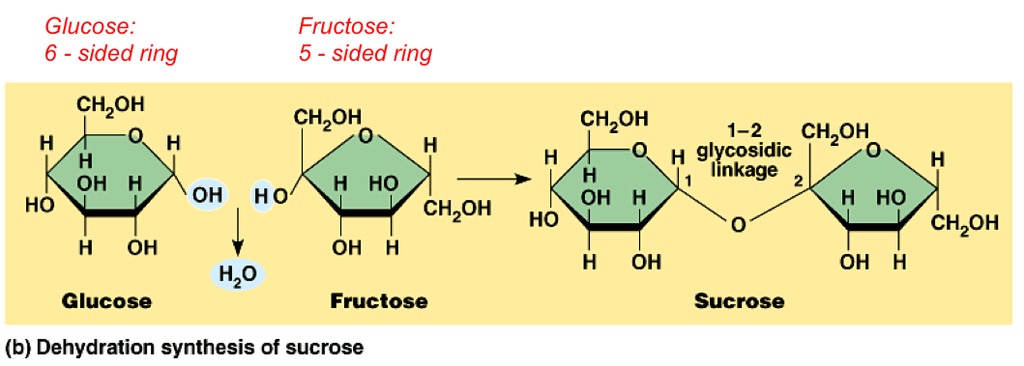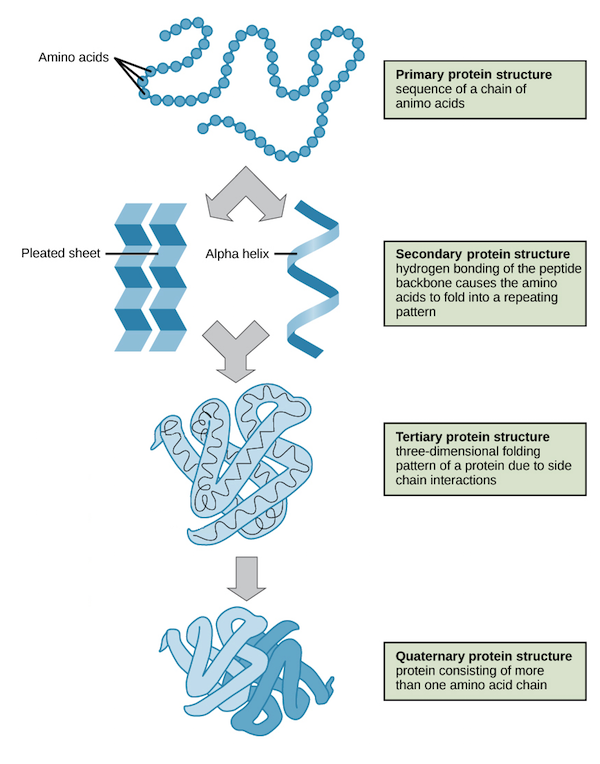Types of Molecules
Carbohydrates
The simplest form of a carbohydrate is a monosaccharide. Monosaccharides consist of a sugar molecule (examples are fructose or glucose). Sugar molecules are usually multiples of CH2O. Glucose has the formula C6H12O6. Fructose has the same formula, but the carbon atoms are arranged in different ways from glucose.
Two monosaccharides can be combined to form a disaccharide. The two monosaccharides join by a glycosidic linkage, which causes a water molecule to be lost. Since a water molecule is lost, the reaction is called a condensation reaction, or a dehydration reaction. When a disaccharide splits apart and turns into two monosaccharides, it undergoes hydrolysis, which requires a water molecule to be added. A couple important disaccharides are displayed below:
- glucose + fructose = H2O + sucrose
- glucose + galactose = H2O + lactose
- glucose + glucose = H2O + maltose

A polysaccharide is a combination of more than two monosaccharides. It can contain hundreds of glucose monomers linked together. A couple important polysaccharides are listed below:
- Starch is a polymer composed of α-glucose molecules. Plant frequently utilize starch as a source of energy.
- Glycogen is also a polymer of α-glucose molecules. Unlike starch, glycogen has a different pattern of polymer branching and is the source of energy in animal cells.
- Cellulose is a polymer of β-glucose molecules. Plant cells use cellulose as a structural molecule for cell walls. Unfortunately, humans cannot digest cellulose. Only specialized organisms such as termites can digest it.
- Chitin is similar to cellulose in that it is also used for structure. However, it is mostly utilized by insects, arthropods, and mollusks for an exoskeleton.

Lipids
Lipids are highly insoluble is water, but can dissolve in nonpolar substances like ether or chloroform.
Lipids can be broken down into major groups:
- Triglycerides (triacylglycerols) are fats and oils. They are made up of three fatty acids that are connected to a glycerol molecule. There are two types of fatty acids: saturated and unsaturated.
- Saturated fatty acids have one covalent bond between each pair of carbon atoms. Since there are no double bonds in saturated fatty acids, thr saturated fatty acid does not have a kink in its structure and can pack together closely. This ability to pack together causes saturated fatty acids to have a higher melting point and therefore are usually solid at room temperature.
- Unsaturated fatty acids, on the other hand, do have a double bond in their structure and therefore have a kink. This causes them to be more spaced out and pack loosely. They have a lower melting point and are usually liquid at room temperature, such as oil.
- Monounsaturated fatty acids have one double covalent bond.
- Polyunsaturated fatty acids have two or more double covalent bonds.
- Steroids, such as testosterone for males and estrogen for females are also lipids. Additionally, cholesterol is a steroid that is part of cell membranes. It helps cell membranes retain fluidity in low temperatures and remain partly solid in high temperatures.

Proteins
Proteins an important part of cells. There are various kinds of proteins:
- Structural proteins give things their structure. Keratin in hair and collagen in connective tissue are examples of connective proteins.
- Storage proteins are proteins that can store various things, such as energy. Casein in milk and zein in corn seeds are example of storage proteins.
- Transport proteins are proteins that can transport various molecules from place to place. An example is hemoglobin in red blood cells. Hemoglobin binds to oxygen and carries it through the red blood cell.
- Defensive proteins are proteins that can fight against infection. An example is antibodies that combat foreign substances in the body.
Proteins have four structures:
- The primary structure of a protein is the sequence of amino acids in the protein.
- The secondary structure of the protein is the 3D structure of the protein. It can be either an alpha helix or a beta pleated sheet.
- The tertiary structure of the protein is also 3D, but includes hydrogen bonding, ionic bonding, and disulfide bonds between amino acids.
- The protein's quaternary structure consists of many polypeptide chains that are overlapping and intertwining.

